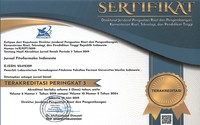Total phenolic and flavonoid compound of crude and purified extract of green tea leaves (Camellia sinensis) from Makassar-Indonesia
Abstract
Keywords
Full Text:
PDFReferences
Silalahi, J. (2002). Polofenolic as Active Compound In Tea. Indonesia Medical Magazine 52(10):361-400.
Chaturvedula, V.S.P. and Prakash, I. (2011). The aroma, taste, color and bioactive constituents of tea. Journal of Medicinal Plants Research 5(11).
Heim, K.E, Tagliaferro, A.R. and Bobliya, D.J. (2002). Flavonoids antioxidants: Chemistry, metabolism and structure activity relationships. The Journal of Nutritional Biochemistry 13: 572- 584.
Neldawati., Ratnawulan and Gusnedi. (2013). Analysis of Absorbance in The Determination of Total Flavonoid in Various Leaves of Plant Medicine. Pillar of physics 2: 76-83.
Redha, A. (2010). Flavonoid: Structure, Antioxidant Effect and The Role in the Biological System. Journal Belian 9(2) : 196 – 202.
Koncić, M., Kremer, D., Gruz, J., Strnad, M., Bisevac, G. and Kosalec, I. (2001). Antioxidant and antimicrobial properties of Moltkia petraea (tratt.) Griseb. flower, leaf and stem infusions. Food Chem Toxicol 48(6):1537–1542.
McDonald, S., Prenzler, P.D., Autolovich, M. and Robards, K. (2001). Phenolic content and antioxidant activity of olive oil extracts. Food Chem Biol Interact 73:73–84.
Nabavi, S., Ebrahimzadeh, M., Nabavi, S., Hamidinia, A. and Bekhradnia, A. (2008). Determination of antioxidant activity, phenol and flavonoids content of Parrotia persica Mey. Pharmacol Online 2:560–567.
Adedapo, A., Jimoh, F., Koduru, S., Masika, J. and Afolayan, A. (2009). Assessment of the medicinal potentials of the methanol extracts of the leaves and stems of Buddleja saligna. BMC Complement Altern Med 9:9–21.
Chang, C., Yang, M., Wen, H. and Chern, J. (2002). Estimation of total flavonoid content in Propolis by two complementary colorimetric methods. Journal of Food and Drug Analisis 10(3): 178-182.
Ebrahimzadeh, M., Nabavi, S. and Nabavi, S. (2001). Antioxidant activities of methanol extract of Sambucus ebulus L. flower. Pak J Biol Sci 12:447–450.
Ordonez, A., Gomez, J., Vattuone, M. and Isla, M. (2006). Antioxidant activities of Sechium edule (Jacq). Food Chem 97:452–458.
DOI: https://doi.org/10.33096/jffi.v9i3.916
Copyright (c) 2022 Muammar Fawwaz

This work is licensed under a Creative Commons Attribution-ShareAlike 4.0 International License.
Indexed by:
ISSN: 2356-0398 | e-ISSN: 2541-2329
Editor's Address:
Third Floor Pharmacognosy-phytochemistry laboratory building, Urip Sumoharjo road km. 5 Campus II UMI, Makassar, South Sulawesi, Indonesia
Phone: +6281524045514
Fax: +62411425619
E-mail: editorjfi@umi.ac.id

















.jpg)

